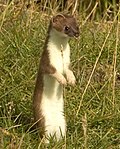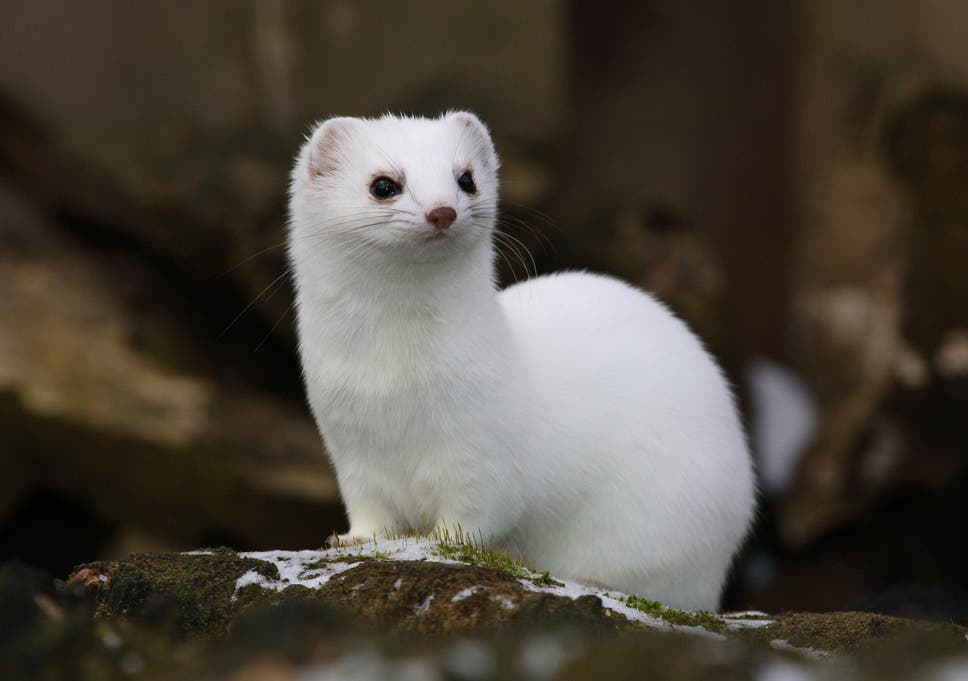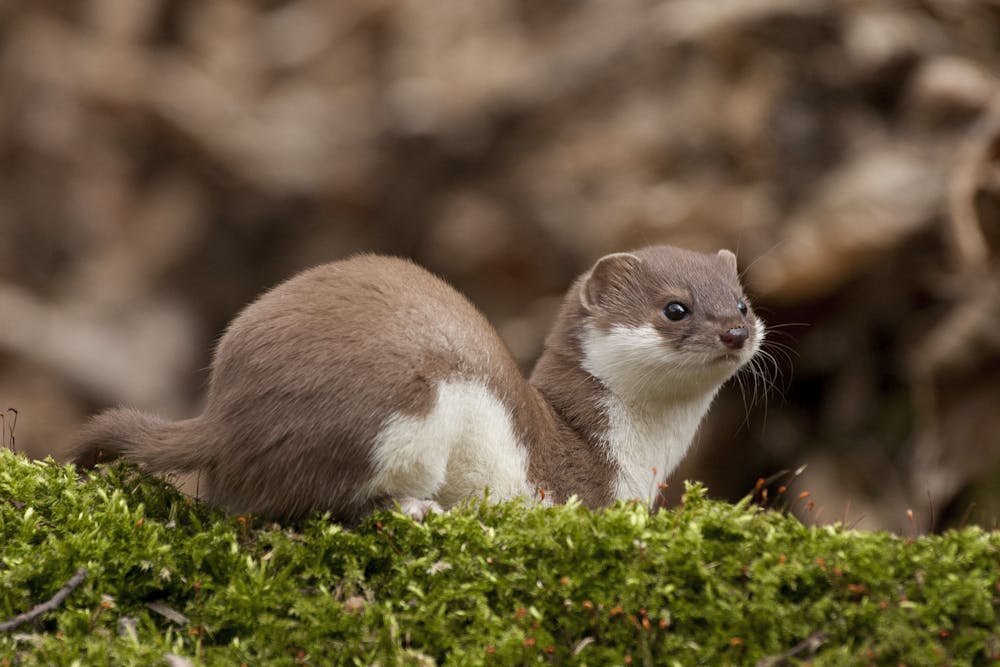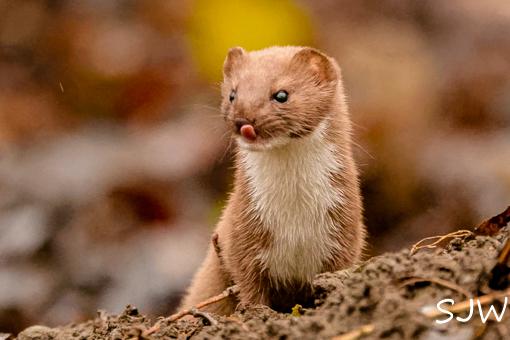Weasels vary in length from 173 to 217 mm (6.8 to 8.5 in),[2] females being smaller than the males, and usually have red or brown upper coats and white bellies; some populations of some species moult to a wholly white coat in winter. They have long, slender bodies, which enable them to follow their prey into burrows. Their tails may be from 34 to 52 mm (1.3 to 2.0 in) long.[2]
Weasels feed on small mammals and have from time to time been considered vermin because some species took poultry from farms or rabbits from commercial warrens. They do, on the other hand, eat large numbers of rodents. They can be found all across the world except for Australia, Antarctica, and the neighbouring islands.
Terminology
The English word "weasel" was originally applied to one species of the genus, the European form of the least weasel (Mustela nivalis). This usage is retained in British English, where the name is also extended to cover several other small species of the genus. However, in technical discourse and in American usage, the term "weasel" can refer to any member of the genus, or to the genus as a whole. Of the 17 extant species currently classified in the genus Mustela, 10 have "weasel" in their common names. Among those that do not are the stoat, the polecats, the ferret, and the European mink. The American mink and the extinct sea mink were commonly included in this genus as Mustela vison and Mustela macrodon, respectively, but in 1999 they were moved to the genus Neovison.[3]Species
The following information is according to the Integrated Taxonomic Information System.| Image | Scientific name | Common Name | Distribution |
|---|---|---|---|
| Mustela africana Desmarest, 1800 | Amazon weasel | South America | |
 |
Mustela altaica Pallas, 1811 | Mountain weasel | Europe and Northern Asia Southern Asia |
 |
Mustela erminea Linnaeus, 1758 | Stoat or Short-tailed weasel |
Europe and Northern Asia North America Southern Asia (non-native) New Zealand (non-native) |
 |
Mustela eversmannii Lesson, 1827 | Steppe polecat | Europe and Northern Asia Southern Asia |
| Mustela felipei Izor and de la Torre, 1978 | Colombian weasel | South America | |
 |
Mustela frenata Lichtenstein, 1831 | Long-tailed weasel | North America South America |
 |
Mustela itatsi Temminck, 1844 | Japanese weasel | Japan and Sakhalin Island (Russia) |
 |
Mustela kathiah Hodgson, 1835 | Yellow-bellied weasel | Southern Asia |
 |
Mustela lutreola (Linnaeus, 1761) | European mink | Europe |
| Mustela lutreolina Robinson and Thomas, 1917 | Indonesian mountain weasel | Southern Asia | |
 |
Mustela nigripes (Audubon and Bachman, 1851) | Black-footed ferret | North America |
 |
Mustela nivalis Linnaeus, 1766 | Least weasel | Europe and Northern Asia North America Southern Asia (non-native) New Zealand (non-native) |
| Mustela nudipes Desmarest, 1822 | Malayan weasel | Southern Asia | |
 |
Mustela putorius Linnaeus, 1758 | European polecat/ Domestic ferret (ssp. furo) |
Europe and Northern Asia New Zealand (ssp. furo; non-native) |
 |
Mustela sibirica Pallas, 1773 | Siberian weasel | Europe and Northern Asia Southern Asia |
 |
Mustela strigidorsa Gray, 1855 | Back-striped weasel | Southern Asia |
 |
Mustela subpalmata Hemprich & Ehrenberg, 1833 | Egyptian weasel | Northern Egypt |
Hybrids in this genus include the polecat–ferret hybrid and the polecat–mink hybrid.
Cultural meanings
Weasels have been assigned a variety of cultural meanings.In Greek culture, a weasel near one's house is a sign of bad luck, even evil, "especially if there is in the household a girl about to be married", since the animal (based on its Greek etymology) was thought to be an unhappy bride who was transformed into a weasel[4] and consequently delights in destroying wedding dresses.[5] In neighboring Macedonia, however, weasels are generally seen as an omen of good fortune.[4][5]
In early-modern Mecklenburg, Germany, amulets from weasels were deemed to have strong magic; the period between August 15 and September 8 was specifically designated for the killing of weasels.[6]:255
In Montagne Noire (France), Ruthenia, and the early medieval culture of the Wends, weasels were not meant to be killed.[6]
In North America, Native Americans (in the region of Chatham County, North Carolina) deemed the weasel to be a bad sign; crossing its path meant a "speedy death".[7] According to Daniel Defoe also, meeting a weasel is a bad omen.[8] In English-speaking areas, weasel can be an insult, noun or verb, for someone regarded as sneaky, conniving or untrustworthy. Similarly, "weasel words" is a critical term for words or phrasing that are vague, misleading or equivocal.
Japanese folklore

Japanese weasel
They are also said to shapeshift like the fox (kitsune) or tanuki, and the nyūdō-bōzu told about in legends in the Tōhoku region and the Chūbu region are considered weasels in disguise, and they are also said to shapeshift into ōnyūdō and little monks.[9]
In the collection of depictions, the Gazu Hyakki Yagyō by Sekien Toriyama, they were depicted under the title 鼬, but they were read not as "itachi", but rather as "ten",[10] and "ten" were considered to be weasels that have reached one hundred years of age and became yōkai that possessed supernatural powers.[11] Another theory is that when weasels reach several hundred years of age, they become mujina (badger).[12]
In Japanese weasels are called iizuna or izuna (飯綱) and in the Tōhoku Region and Shinshu, it was believed that there were families that were able to use a certain practice to freely use kudagitsune as iizuna-tsukai or kitsune-mochi. It is said that Mount Iizuna, from the Nagano Prefecture, got its name due to how the gods gave people mastery of this technique from there.[13]
According to the folkloristician Mutō Tetsujō, "They are called izuna in the Senboku District,[* 1] Akita Prefecture, and there are also the ichiko (itako) that use them."[14] Also, in the Kitaakita District, they are called mōsuke (猛助), and they are feared as yōkai even more than foxes (kitsune).[14]
In the Ainu language, ermines are called upas-čironnup or sáčiri, but since least weasels are also called sáčiri, Mashio Chiri surmised that the honorary title poy-sáčiri-kamuy (where poy means "small") refers to least weasels.[15]
Kamaitachi
Kamaitachi is a phenomenon wherein one who is idle is suddenly injured as if his or her skin were cut by a scythe. In the past, this was thought to be "the deed of an invisible yōkai weasel". An alternate theory, asserts that kamaitachi is derived from kamae Tachi (構え太刀, "stance sword"), so were not originally related to weasels at all.[16]Mustela erminea

Mustela range

Domestic ferret (Mustela putorius furo) in the Melitopol Zoo, Ukraine






No comments:
Post a Comment
Note: Only a member of this blog may post a comment.